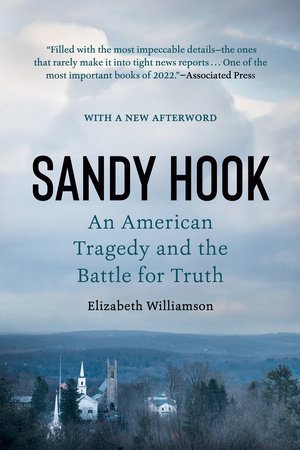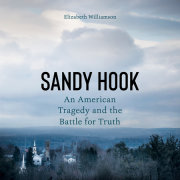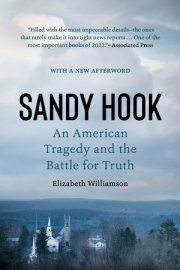1
Newtown, Connecticut
January 2019
Do you see the stars?"
It was nearly dusk, the end of our car tour of Newtown, when Neil Heslin directed me to stop on a hilltop side street off Riverside Road. Below and across Riverside stands the volunteer firehouse, and down a long drive beyond it, Sandy Hook Elementary School.
It had been seven years since the shooting. Neil's question seemed at first like an effort to lighten the mood. Our conversation had been grim to that point, and I had noticed my mind edging away, like the lazy V of geese I saw retreating toward the silhouette tree line. I smiled and craned my head to peer through the windshield, then saw that Neil was pointing across the road to the sloping roof of the firehouse. Arranged in waves suggesting a constellation, twenty-six copper barnstars gleamed dully in the fading light. One for each of the twenty children and for the six educators who died trying to protect them. The five-pointed stars were so large-seven feet across for the educators', five feet for the children's, that I was surprised not to have noticed them right away. A local carpenter named Greg Gnandt, whose cousin was a firefighter for the Sandy Hook Volunteer Fire & Rescue, made them in his shop, coating them with lacquer to protect their shine. About two weeks after the shooting, Gnandt and a crew of volunteers mounted them to the roof of the firehouse, the building where the governor had told twenty-six waiting families that no one else had survived.
One of the stars honors Jesse Lewis, Neil Heslin and Scarlett Lewis's six-year-old boy. He was Scarlett's second-born, the little brother of J.T., six years older. Jesse was Neil's only child and, as he has often said, his only family.
Jesse's star is positioned "front and center, just like he would be," Scarlett once told me. Scarlett moved from Fayetteville, Arkansas, to Sandy Hook in 1998. She grew up in Darien, Connecticut. An avid horsewoman and artist, she sought a quieter life in Sandy Hook with more room for both. She bought a picturesque spread on Great Ring Road, with a creamy yellow eighteenth-century clapboard house and a red barn for her horses, and named it Wild Rose Farm. Scarlett worked then for a technology firm in New York that had created a financial trading system, a job that involved visiting the financial houses that had flocked into Fairfield County. In 2000, two years after she moved to Sandy Hook, her son J.T. was born, but her relationship with his father frayed a few years later. Scarlett met Neil in the Blue Heron, an antique shop in Milford owned by her mother, Maureen, who had moved to Newtown to be near Scarlett and J.T. Neil had grown up in nearby Shelton and had a small construction business. They struck up a conversation about a tree that had come down on her farm, and Neil offered to remove it for her.
"Neil was really fun," Scarlett told me, a problem solver and good-natured partner in part-time farming. She wanted sheep and bought a "spinner's flock," one in every color. Thanks to inexperience and bad timing, they wound up raising lambs born in January inside the farmhouse, drying them and keeping them warm with a hair dryer. "We had lots of farm adventures," Scarlett said, laughing at the memory.
Their son, Jesse, was born in 2006. Neil and Scarlett split up when Jesse was a baby, but they shared parenting.
Jesse had deep brown, almond-shaped eyes, a broad smile, and a deep voice for a kid that age, bellowing "Heeeere's Jesse!" when he entered a room. He liked to play "army guys," wearing a flopping plastic camouflage helmet and rubber boots on missions around the farm, where he kept a shaggy burro named Turquoise, his pony named Chocolate, and his and J.T.'s drooling mastiff pup, Remington.
Jesse had stayed with Neil the day before the shooting, in the house Neil inherited from his parents in Shelton, about seven miles southeast of Scarlett's place, a modest ranch with a deep, wooded front yard. About 7:30 in the morning on Wednesday, December 12, Neil drove up Scarlett's gravel drive, past the red barn, to collect Jesse. While his parents chatted, Jesse scratched "I love you" into the light frost coating Scarlett's car door, surrounding the message with hearts. Scarlett told him to stay put and ran into the house for her camera. Her last photo of Jesse is of him squinting in the morning sun, showing off his handiwork. His ski jacket was open, revealing an untucked rugby jersey with blue and black stripes, the shirt he died in.
Neil is tall with a rangy build, partial to jeans, square-toed Western boots, and work shirts, more comfortable outdoors than in. His words emerge in slow eddies, his deferential demeanor accentuated by a shrug, a tic that's more noticeable when visiting uncomfortable topics. When angry, he speaks in flinty bursts punctuated by profanity.
Neil carried his grief like hard water in a metal container, blunting its corrosive power by staying in motion, starting projects, fixing things. When Scarlett's livestock gate swung open one night while she was traveling and her horses strayed into the road, he went over to find and pen them. When Heart, her favorite old mare, died, he brought his backhoe and buried the horse on her land. One recent, difficult Mother's Day, he turned up at the farm to help her put in a kitchen garden. On this day he served as my guide to Newtown, pointing out the landmarks of his loss.
We talked best together in the car. Neil gave directions and thought aloud while I drove, his recollections flowing out while he gazed through the window, his face angled so hard against the glass sometimes that it fogged. He's one of the survivors who refer to the shooting as "the tragedy." Others call it "12/14," a term that, like "9/11," denotes a reverberating catastrophe. Any reference to the shooting by less sheltering terms sounds to Newtown ears like an obscenity, particularly when uttered by outsiders who did not live through it.
Newtown's story began in 1705, when settlers from Connecticut and New York "purchased" from its Native inhabitants an eight-mile-long, roughly six-mile-wide parcel on the northeast edge of Fairfield County. The site hugged the Housatonic and Pootatuck Rivers, the latter named for the Native people who traded their farming and fishing grounds for a small haul of goods, including four guns.
Newtown looks like what you might imagine when someone says "picturesque New England town." Curving narrow roads lined with low rock walls; grassy, misty culverts radiating from its downtown; a colonial hilltop idyll, distinguished even from afar by a steepled white clapboard church and the hundred-foot flagpole, a beloved local hazard, that in a fit of patriotic fervor during the 1876 American centennial was planted smack in the center of Main Street. Newtown also has its share of fast-food places and boxy tract houses, testimony to the New York exurban sprawl that nearly quadrupled its population between 1950 and 2010.
In 1956, on a vacant, scrubby parcel at the intersection of its colonial past and suburban future, Newtown built a new school for the children of the baby boom. Sandy Hook Elementary was designed to shield its young students from mid-century parents' chief terror: fire. Just two years prior, a blaze in a wooden annex at Cleveland Hill Elementary School in Cheektowaga, New York, had killed fifteen children, prompting urgent calls for new building standards. Sandy Hook school was brick, built low and squat, with big windows, walls of pastel-glazed brick, and terrazzo floors speckled like birds' eggs. In a last, proud touch, the builders marked the wooded drive leading to its entrance with a white wooden shingle hanging from iron brackets. sandy hook school 1956, it announced. visitors welcome.
Before December 14, 2012, taxes and unbridled growth, not crime or violence, remained Newtown's principal preoccupations. In a book marking Newtown's tercentennial in 2005, old-timers lamented the loss of farms and forests, portraying "more homes, lawns and roads" as the chief threat to Newtown's treasured ordinariness. If only.
Neil is not given to dark theorizing or magical thinking. But after Jesse's death, his search for meaning took him to places that his logical mind knew held no answers. Why, of all the mayhem-plagued hellscapes in America, had the shooting happened in this serene, prosperous place, which Pat Llodra, the town's first selectman, once called "close to big-city culture, without any of the big-city problems," and Neil called "Mayberry"? In Newtown the right way to live was literally mapped out on a poster that hung in the front lobby of Sandy Hook Elementary School on the day Lanza blew out the window. It depicted a tree and was titled "Cultivating Character: Newtown's Core Character Attributes." At the tree's roots, "Perseverance." Along its trunk, "Citizenship." Springing from that sturdy stem, "Caring," "Respect," "Trustworthiness," and "Responsibility."
What if General Electric had not moved from Manhattan to Fairfield County in the early 1970s, bringing scores of executives to Newtown? Maybe then Peter Lanza, his wife, Nancy, and their troubled younger son, Adam, would never have moved into a roomy subdivision whose children attended Sandy Hook.
We drove past the rolling grounds and empty red-brick colonial buildings of the former Fairfield Hills mental hospital, their white-painted colonnades peeling, broken windows gaping like sightless eyes. Fairfield State Hospital accepted its first residents in 1933. At its peak it housed four thousand patients on its eight-hundred-acre campus and employed hundreds of locals. It closed in 1995, an anachronism in an age of outpatient treatment. Newtown bought a chunk of the campus to house municipal operations and other potential projects.
Fairfield Hills' brooding emptiness lured urban explorers and ghost hunters, who prowled through its network of underground tunnels. Videos of the complex's deserted morgue appeared on blogs and later, on the nascent video-sharing site YouTube, narrators hyperventilating about phantom psychotic screams and sightings. Newtown responded to its first brush with internet-borne delusion by arresting trespassers and tearing down the morgue. The Newtown Bee newspaper, since its founding in 1877 a civic guardian against "gossip, grudges, hate and scandal," posted a video of the demolition to YouTube.
Neil marveled at the irony. His son was murdered in the exact town where two decades earlier a disturbed young man might have been hospitalized and supervised. If Fairfield Hills had remained open, maybe his son's killer would have been doing chores on Fairfield Hills' dairy farm, instead of holing up in the basement of a house with an arsenal, searching up mass shootings on Google and plugging them into a spreadsheet.
Of all his what-if questions, the most torturous swirled around Neil's last day with Jesse. His son had seemed uncharacteristically quiet, even sad. Did Jesse somehow sense his fate? Could Neil have done something differently and saved his life?
Neil let Jesse sleep in a little longer on Friday morning. When Jesse awoke, "he wasn't really himself, it didn't seem like," Neil recalled. "He just seemed a little more withdrawn-I don't know how you would describe it." Neil also felt a little down. His mother had died five years earlier on that day, December 14. Neil glanced at a framed photograph on the living room end table of his mother and an infant Jesse at Christmas. He had recently found Jesse gazing at it too.
"I don't remember Grandma," Jesse told him.
"'Well, you were young,'" Neil replied. Then "Jesse went back and looked at the photo and studied it, really studied it. And he said, 'I'll know Grandma when I see her.'
"It was strange. Ah, it was just strange."
Jesse dawdled that morning. Neil told him that if they hurried, they could stop at the Misty Vale Deli for breakfast on the way to school. They hustled to get dressed, and Jesse grabbed his backpack, printed with Pixar characters from the Disney movie Cars. That day it was stuffed with crumpled papers and a couple of library books, and his snack, a plastic bag of orange sections. After breakfast, driving down winding roads in brilliant sunshine, Jesse still seemed off-kilter. Neil pointed out all the things they had to look forward to, starting at two o'clock that afternoon, when he and Scarlett would join the first graders in decorating gingerbread houses.
Again, "I asked if he was all right. And I thought, 'I wonder if I should just keep him home?'" Neil told me.
Neil dropped Jesse off at school. "He gave me a big hug, which I can still feel, and told me, 'Everything's gonna be okay,'" Neil recalled. Taken aback by that strangely adult reassurance, Neil reminded Jesse that he'd be back in just a couple of hours for the gingerbread-house party. But Jesse shook his head, telling his father, "'That's not gonna happen. We're not doing that today.'
"That was that. I walked him in, the bell went off at 9:04, he hugged me again," Neil said. Looking his father in the face, his hands on his shoulders, "he said, 'I love you. I love Mom too,' and kind of darted around the corner," Neil recalled.
"If we weren't making those damned gingerbreads, I probably would have kept him home," Neil said, adding, as he often does, "It is what it is."
Neil was running errands around Newtown shortly after ten that morning when he got the first emergency text message from Sandy Hook Elementary, the same type it sends for a snow day. "It said the school's on lockdown, and a couple of minutes later it said the school was on lockdown because there was a shooting in town," he recalled. Not overly alarming, except for the shooting part. After 9/11, schools tended to lock down even for distant threats.
Another message arrived: the shooting involved a school. Neil called Scarlett, or maybe Scarlett called him, after they both heard vague reports that the school was Sandy Hook, something about someone being shot in the foot.
"'Well, maybe it was a teacher, a disgruntled parent, a husband and wife, an isolated thing,' I don't know," Neil recalled wondering at the time. He set off for Sandy Hook.
Scarlett thought it was probably another false alarm. She figured she may as well go to the school anyway, in case Jesse was worried about whatever had happened and wanted his mom.
Neil got there first. He found a scene "like a combat zone," Riverside Road and Dickinson Drive, the intersection nearest the school, jammed with cars and emergency vehicles. Inside and around the firehouse on Riverside he saw kids and teachers carrying signs with classroom numbers written on them. But he didn't see Jesse's room number, 10, and he didn't see Jesse. "Nothing was real clear," he told me. "All you knew was something happened, and they evacuated the kids. There wasn't a lot of information being given out there. I think the media"—whose camera crews and satellite trucks had already engulfed the firehouse parking lot and the hilltop overlooking it-"actually had more, but all I knew was, Jesse wasn't anywhere."
Copyright © 2022 by Elizabeth Williamson. All rights reserved. No part of this excerpt may be reproduced or reprinted without permission in writing from the publisher.








